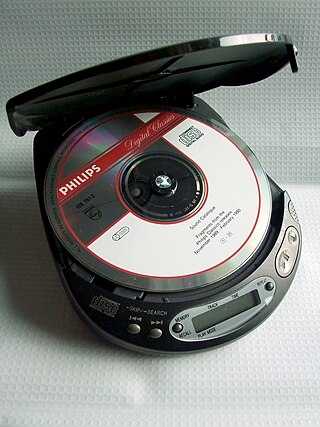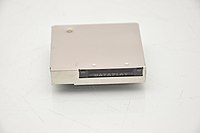
The compact disc (CD) is a digital optical disc data storage format that was co-developed by Philips and Sony to store and play digital audio recordings. In August 1982, the first compact disc was manufactured. It was then released in October 1982 in Japan and branded as Digital Audio Compact Disc.

CD-R is a digital optical disc storage format. A CD-R disc is a compact disc that can be written once and read arbitrarily many times.

An optical disc is a flat, usually disc-shaped object that stores information in the form of physical variations on its surface that can be read with the aid of a beam of light. Optical discs can be reflective, where the light source and detector are on the same side of the disc, or transmissive, where light shines through the disc to be detected on the other side.

Video CD is a home video format and the first format for distributing films on standard 120 mm (4.7 in) optical discs. The format was widely adopted in Southeast Asia, South Asia, Greater China, Central Asia and West Asia, superseding the VHS and Betamax systems in the regions until DVD-Video finally became affordable in the first decade of the 21st century.
A disk image is a snapshot of a storage device's structure and data typically stored in one or more computer files on another storage device. Traditionally, disk images were bit-by-bit copies of every sector on a hard disk often created for digital forensic purposes, but it is now common to only copy allocated data to reduce storage space. Compression and deduplication are commonly used to reduce the size of the image file set. Disk imaging is done for a variety of purposes including digital forensics, cloud computing, system administration, as part of a backup strategy, and legacy emulation as part of a digital preservation strategy. Disk images can be made in a variety of formats depending on the purpose. Virtual disk images are intended to be used for cloud computing, ISO images are intended to emulate optical media and raw disk images are used for forensic purposes. Proprietary formats are typically used by disk imaging software. Despite the benefits of disk imaging the storage costs can be high, management can be difficult and they can be time consuming to create.

A CD player is an electronic device that plays audio compact discs, which are a digital optical disc data storage format. CD players were first sold to consumers in 1982. CDs typically contain recordings of audio material such as music or audiobooks. CD players may be part of home stereo systems, car audio systems, personal computers, or portable CD players such as CD boomboxes. Most CD players produce an output signal via a headphone jack or RCA jacks. To use a CD player in a home stereo system, the user connects an RCA cable from the RCA jacks to a hi-fi and loudspeakers for listening to music. To listen to music using a CD player with a headphone output jack, the user plugs headphones or earphones into the headphone jack.

In computing, an optical disc drive is a disc drive that uses laser light or electromagnetic waves within or near the visible light spectrum as part of the process of reading or writing data to or from optical discs. Some drives can only read from certain discs, but recent drives can both read and record, also called burners or writers. Compact discs, DVDs, and Blu-ray discs are common types of optical media which can be read and recorded by such drives.
An optical disc image is a disk image that contains everything that would be written to an optical disc, disk sector by disc sector, including the optical disc file system. ISO images contain the binary image of an optical media file system, including the data in its files in binary format, copied exactly as they were stored on the disc. The data inside the ISO image will be structured according to the file system that was used on the optical disc from which it was created.

A magneto-optical drive is a kind of optical disc drive capable of writing and rewriting data upon a magneto-optical disc. 130 mm (5.25 in) and 90 mm (3.5 in) discs were the most common sizes. In 1983, just a year after the introduction of the compact disc, Kees Schouhamer Immink and Joseph Braat presented the first experiments with erasable magneto-optical compact discs during the 73rd AES Convention in Eindhoven. The technology was introduced commercially in 1985. Although optical, they normally appear as hard disk drives to an operating system and can be formatted with any file system. Magneto-optical drives were common in some countries, such as Japan, but have fallen into disuse.

Optical disc authoring, including CD, DVD, and Blu-ray Disc authoring, is the process of assembling source material—video, audio or other data—into the proper logical volume format to then be recorded ("burned") onto an optical disc. This act is sometimes done illegally, by pirating copyrighted material without permission from the original artists.

GD-ROM is a proprietary optical disc format originally used for the Dreamcast video game console, as well as its arcade counterpart, the Sega NAOMI and select Triforce arcade board titles. It was developed by Yamaha to curb piracy common to standard CDs and to offer increased storage capacity without the expense of the fledgling DVD-ROM. It is similar to the standard CD-ROM except that the pits on the disc are packed more closely together, resulting in a higher storage capacity of 1 gigabyte, a 30% increase over a conventional CD's capacity of 700 megabytes.
SafeDisc is a copy protection program for Microsoft Windows applications and games distributed on optical disc. Created by Macrovision Corporation, it was aimed to hinder unauthorized disc duplication. The program was first introduced in 1998 and was discontinued on March 31, 2009.

Mini CDs, or pocket CDs, are CDs with a smaller diameter and one-third the storage capacity of a standard 120 mm disc.

Optical storage refers to a class of data storage systems that use light to read or write data to an underlying optical media. Although a number of optical formats have been used over time, the most common examples are optical disks like the compact disc (CD) and DVD. Reading and writing methods have also varied over time, but most modern systems as of 2023 use lasers as the light source and use it both for reading and writing to the discs. Britannica notes that it "uses low-power laser beams to record and retrieve digital (binary) data."

DVD recordable and DVD rewritable are optical disc recording technologies. Both terms describe DVD optical discs that can be written to by a DVD recorder, whereas only 'rewritable' discs are able to erase and rewrite data. Data is written ('burned') to the disc by a laser, rather than the data being 'pressed' onto the disc during manufacture, like a DVD-ROM. Pressing is used in mass production, primarily for the distribution of home video.

Optical disc authoring requires a number of different optical disc recorder technologies working in tandem, from the optical disc media to the firmware to the control electronics of the optical disc drive.
In computer hardware, a caddy is a container used to hold some medium, such as a CD-ROM. If the medium is a hard disk drive, the caddy is also referred to as a disk enclosure. Its functionality is similar to that of the 3.5" floppy disk's jacket.

Blu-ray is a digital optical disc data storage format designed to supersede the DVD format. It was invented and developed in 2005 and released worldwide on June 20, 2006, capable of storing several hours of high-definition video. The main application of Blu-ray is as a medium for video material such as feature films and for the physical distribution of video games for the PlayStation 3, PlayStation 4, PlayStation 5, Xbox One, and Xbox Series X. The name refers to the blue laser used to read the disc, which allows information to be stored at a greater density than is possible with the longer-wavelength red laser used for DVDs.

HD DVD is an obsolete high-density optical disc format for storing data and playback of high-definition video. Supported principally by Toshiba, HD DVD was envisioned to be the successor to the standard DVD format, but lost to Blu-ray, supported by Sony and others.

A CD-ROM is a type of read-only memory consisting of a pre-pressed optical compact disc that contains data. Computers can read—but not write or erase—CD-ROMs. Some CDs, called enhanced CDs, hold both computer data and audio with the latter capable of being played on a CD player, while data is only usable on a computer.















